Individual, Team, and Organizational Development for HR Professionals
VerifiedAdded on 2023/06/08
|14
|4506
|119
Report
AI Summary
This assignment provides a comprehensive analysis of the skills, knowledge, and behavior required by HR professionals. It includes a personal skill audit and a professional development plan, highlighting the importance of continuous learning and development in achieving sustainable business performance. The report differentiates between individual and organizational learning, as well as training and development, while also evaluating the advantages of high-performance working. Furthermore, it examines different approaches to performance management and their role in implementing a high-performance culture and commitment within an organization. This document, contributed by a student and available on Desklib, offers valuable insights for those studying human resource management.
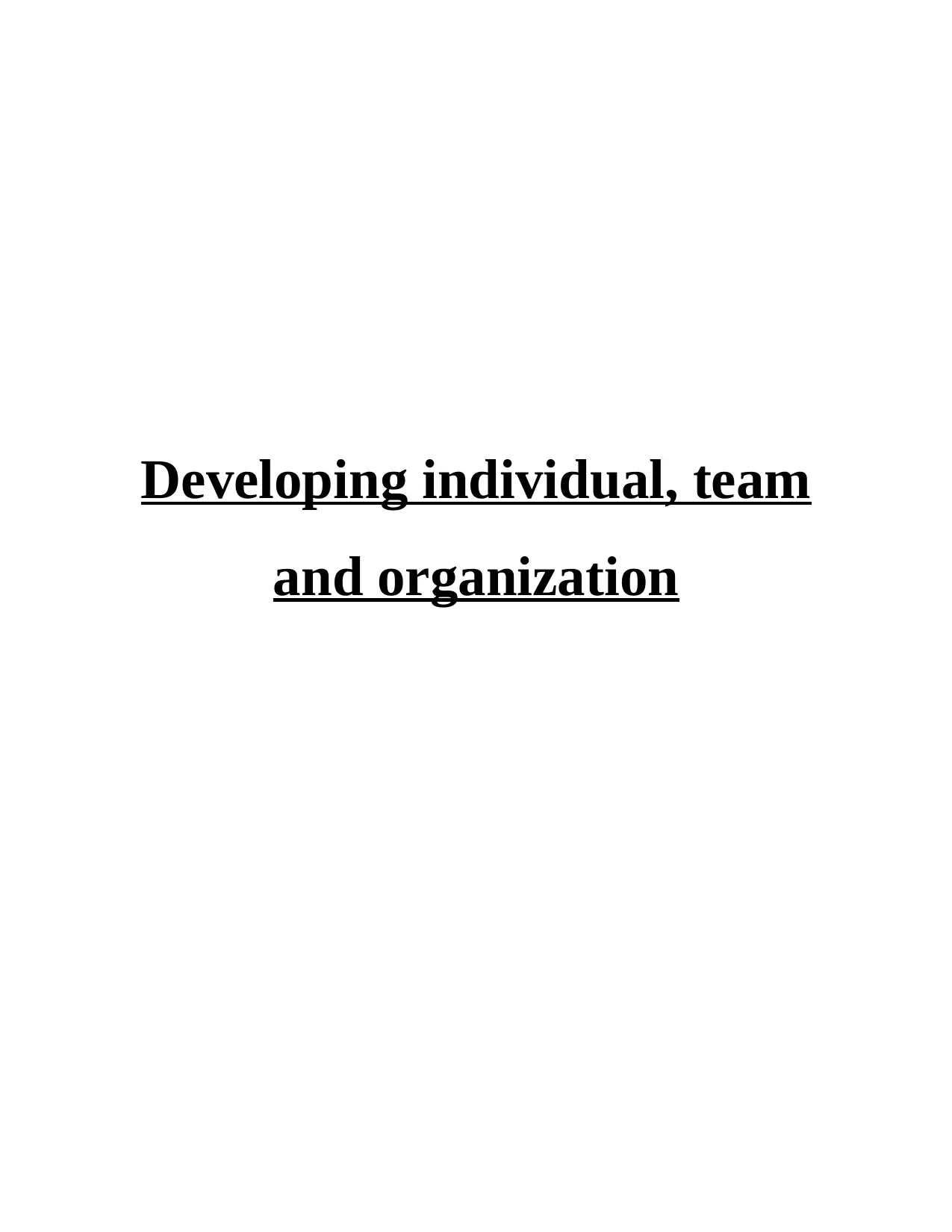
Developing individual, team
and organization
and organization
Paraphrase This Document
Need a fresh take? Get an instant paraphrase of this document with our AI Paraphraser
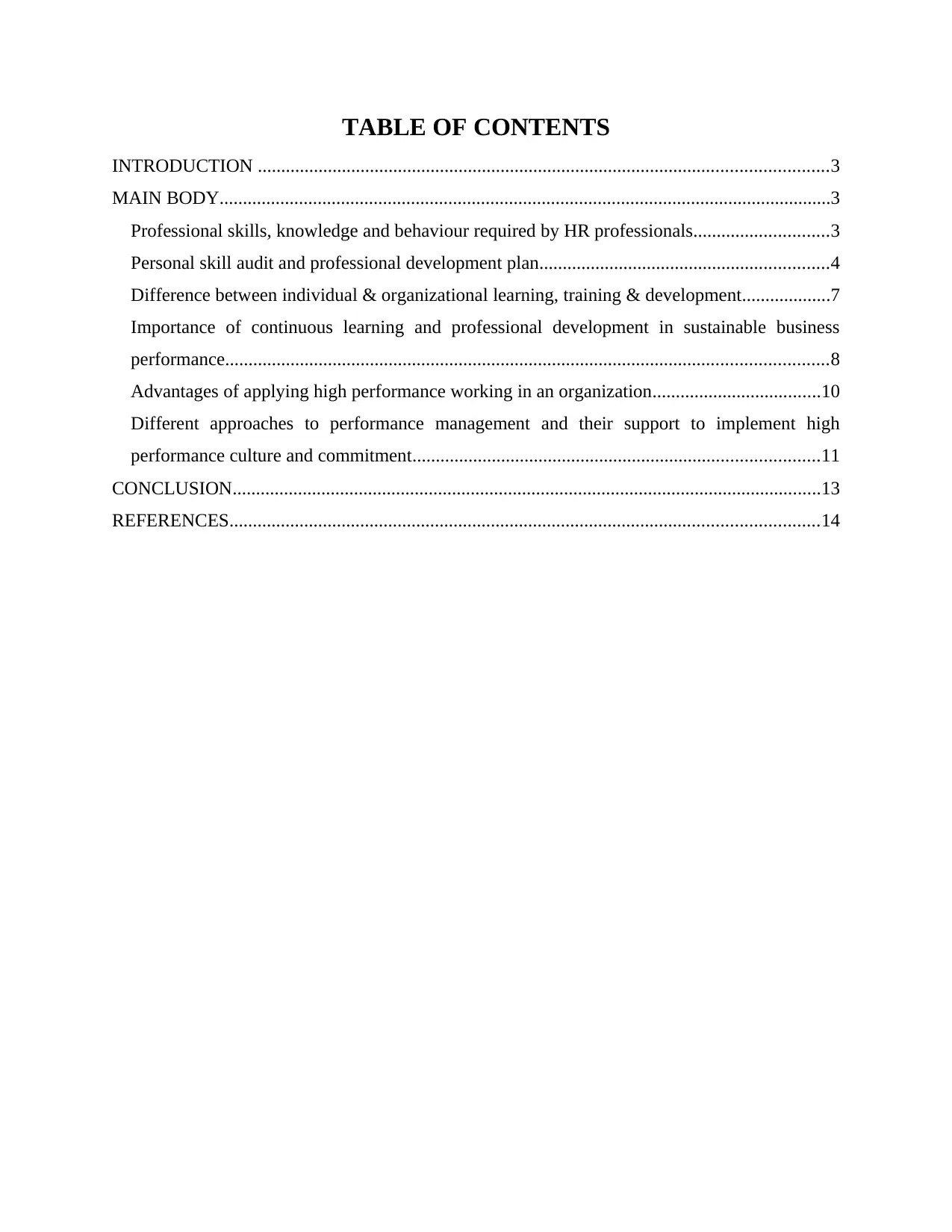
TABLE OF CONTENTS
INTRODUCTION ..........................................................................................................................3
MAIN BODY...................................................................................................................................3
Professional skills, knowledge and behaviour required by HR professionals.............................3
Personal skill audit and professional development plan..............................................................4
Difference between individual & organizational learning, training & development...................7
Importance of continuous learning and professional development in sustainable business
performance.................................................................................................................................8
Advantages of applying high performance working in an organization....................................10
Different approaches to performance management and their support to implement high
performance culture and commitment.......................................................................................11
CONCLUSION..............................................................................................................................13
REFERENCES..............................................................................................................................14
INTRODUCTION ..........................................................................................................................3
MAIN BODY...................................................................................................................................3
Professional skills, knowledge and behaviour required by HR professionals.............................3
Personal skill audit and professional development plan..............................................................4
Difference between individual & organizational learning, training & development...................7
Importance of continuous learning and professional development in sustainable business
performance.................................................................................................................................8
Advantages of applying high performance working in an organization....................................10
Different approaches to performance management and their support to implement high
performance culture and commitment.......................................................................................11
CONCLUSION..............................................................................................................................13
REFERENCES..............................................................................................................................14
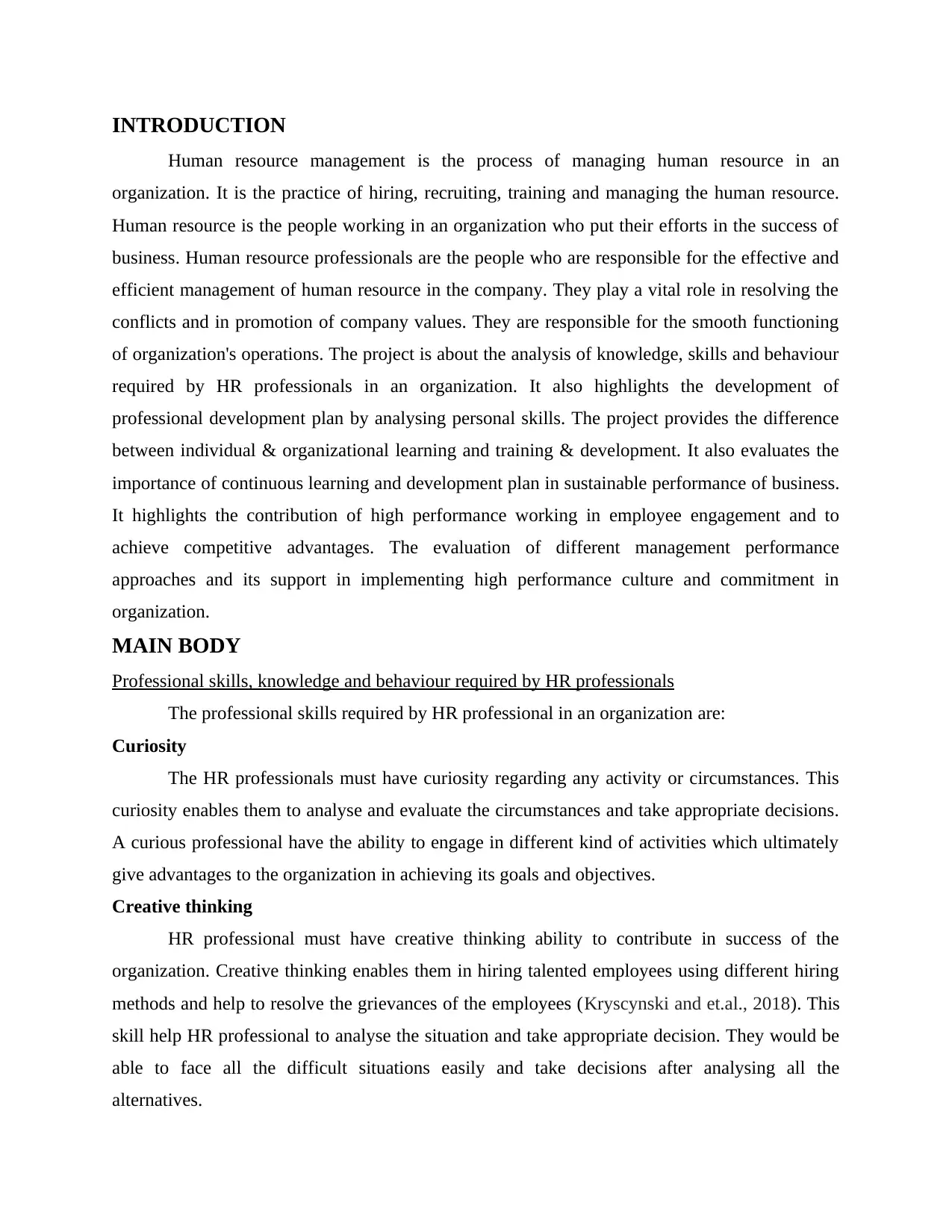
INTRODUCTION
Human resource management is the process of managing human resource in an
organization. It is the practice of hiring, recruiting, training and managing the human resource.
Human resource is the people working in an organization who put their efforts in the success of
business. Human resource professionals are the people who are responsible for the effective and
efficient management of human resource in the company. They play a vital role in resolving the
conflicts and in promotion of company values. They are responsible for the smooth functioning
of organization's operations. The project is about the analysis of knowledge, skills and behaviour
required by HR professionals in an organization. It also highlights the development of
professional development plan by analysing personal skills. The project provides the difference
between individual & organizational learning and training & development. It also evaluates the
importance of continuous learning and development plan in sustainable performance of business.
It highlights the contribution of high performance working in employee engagement and to
achieve competitive advantages. The evaluation of different management performance
approaches and its support in implementing high performance culture and commitment in
organization.
MAIN BODY
Professional skills, knowledge and behaviour required by HR professionals
The professional skills required by HR professional in an organization are:
Curiosity
The HR professionals must have curiosity regarding any activity or circumstances. This
curiosity enables them to analyse and evaluate the circumstances and take appropriate decisions.
A curious professional have the ability to engage in different kind of activities which ultimately
give advantages to the organization in achieving its goals and objectives.
Creative thinking
HR professional must have creative thinking ability to contribute in success of the
organization. Creative thinking enables them in hiring talented employees using different hiring
methods and help to resolve the grievances of the employees (Kryscynski and et.al., 2018). This
skill help HR professional to analyse the situation and take appropriate decision. They would be
able to face all the difficult situations easily and take decisions after analysing all the
alternatives.
Human resource management is the process of managing human resource in an
organization. It is the practice of hiring, recruiting, training and managing the human resource.
Human resource is the people working in an organization who put their efforts in the success of
business. Human resource professionals are the people who are responsible for the effective and
efficient management of human resource in the company. They play a vital role in resolving the
conflicts and in promotion of company values. They are responsible for the smooth functioning
of organization's operations. The project is about the analysis of knowledge, skills and behaviour
required by HR professionals in an organization. It also highlights the development of
professional development plan by analysing personal skills. The project provides the difference
between individual & organizational learning and training & development. It also evaluates the
importance of continuous learning and development plan in sustainable performance of business.
It highlights the contribution of high performance working in employee engagement and to
achieve competitive advantages. The evaluation of different management performance
approaches and its support in implementing high performance culture and commitment in
organization.
MAIN BODY
Professional skills, knowledge and behaviour required by HR professionals
The professional skills required by HR professional in an organization are:
Curiosity
The HR professionals must have curiosity regarding any activity or circumstances. This
curiosity enables them to analyse and evaluate the circumstances and take appropriate decisions.
A curious professional have the ability to engage in different kind of activities which ultimately
give advantages to the organization in achieving its goals and objectives.
Creative thinking
HR professional must have creative thinking ability to contribute in success of the
organization. Creative thinking enables them in hiring talented employees using different hiring
methods and help to resolve the grievances of the employees (Kryscynski and et.al., 2018). This
skill help HR professional to analyse the situation and take appropriate decision. They would be
able to face all the difficult situations easily and take decisions after analysing all the
alternatives.
⊘ This is a preview!⊘
Do you want full access?
Subscribe today to unlock all pages.

Trusted by 1+ million students worldwide

Interpersonal skills
The HR must have the interpersonal skills to influence different kind of people within
and outside the organization. This skill helps to attract the employees and develop trust and
confidence for HR. This enables them to increase their productivity and add value to the
organization. There are diverse employees working in an organization and interpersonal skills
enable the HR to develop relationship with them and encourage employees to improve their
performance.
Collaborative
In an organization there are diverse employees with different culture and behaviour. It is
the responsibility of HR professionals to control them and enable them to work in a team. HR
must have the ability to help the employees to work in a team and avoid conflicts among them
(Abhishek and Divyashree, 2019). HR needs to make employees understand different cultures
and encourage them to corporate with other team members and resolve any grievances.
Evaluation of performance
HR must evaluate the performance of the employees and give feedback to employees
regarding their performance. This will boost their confidence and help them in improving their
performance. Performance based incentives given by HR will motivate employees to give better
performance. Increase in performance of employees will lead to increase in organizational
performance and increase profit margin. The employee satisfaction is one of the important aim of
the HR and this can be achieved by giving value and providing better service to employees.
Courage to take challenges
HR should have courage to challenges and need to take corrective measures which would
enable the organization to accomplish its goals and objectives. HR professionals must have the
ability to encourage their employees to face the challenges confidently. A proper plan and
strategy must be developed after forecasting the circumstances.
Personal skill audit and professional development plan
Communication skill
HR professionals must have effective communication skills as they need to communicate
with different people in an organization. They must have an excellent writing skills to avoid
miscommunication. The effective communication also includes good listening power and clear
The HR must have the interpersonal skills to influence different kind of people within
and outside the organization. This skill helps to attract the employees and develop trust and
confidence for HR. This enables them to increase their productivity and add value to the
organization. There are diverse employees working in an organization and interpersonal skills
enable the HR to develop relationship with them and encourage employees to improve their
performance.
Collaborative
In an organization there are diverse employees with different culture and behaviour. It is
the responsibility of HR professionals to control them and enable them to work in a team. HR
must have the ability to help the employees to work in a team and avoid conflicts among them
(Abhishek and Divyashree, 2019). HR needs to make employees understand different cultures
and encourage them to corporate with other team members and resolve any grievances.
Evaluation of performance
HR must evaluate the performance of the employees and give feedback to employees
regarding their performance. This will boost their confidence and help them in improving their
performance. Performance based incentives given by HR will motivate employees to give better
performance. Increase in performance of employees will lead to increase in organizational
performance and increase profit margin. The employee satisfaction is one of the important aim of
the HR and this can be achieved by giving value and providing better service to employees.
Courage to take challenges
HR should have courage to challenges and need to take corrective measures which would
enable the organization to accomplish its goals and objectives. HR professionals must have the
ability to encourage their employees to face the challenges confidently. A proper plan and
strategy must be developed after forecasting the circumstances.
Personal skill audit and professional development plan
Communication skill
HR professionals must have effective communication skills as they need to communicate
with different people in an organization. They must have an excellent writing skills to avoid
miscommunication. The effective communication also includes good listening power and clear
Paraphrase This Document
Need a fresh take? Get an instant paraphrase of this document with our AI Paraphraser
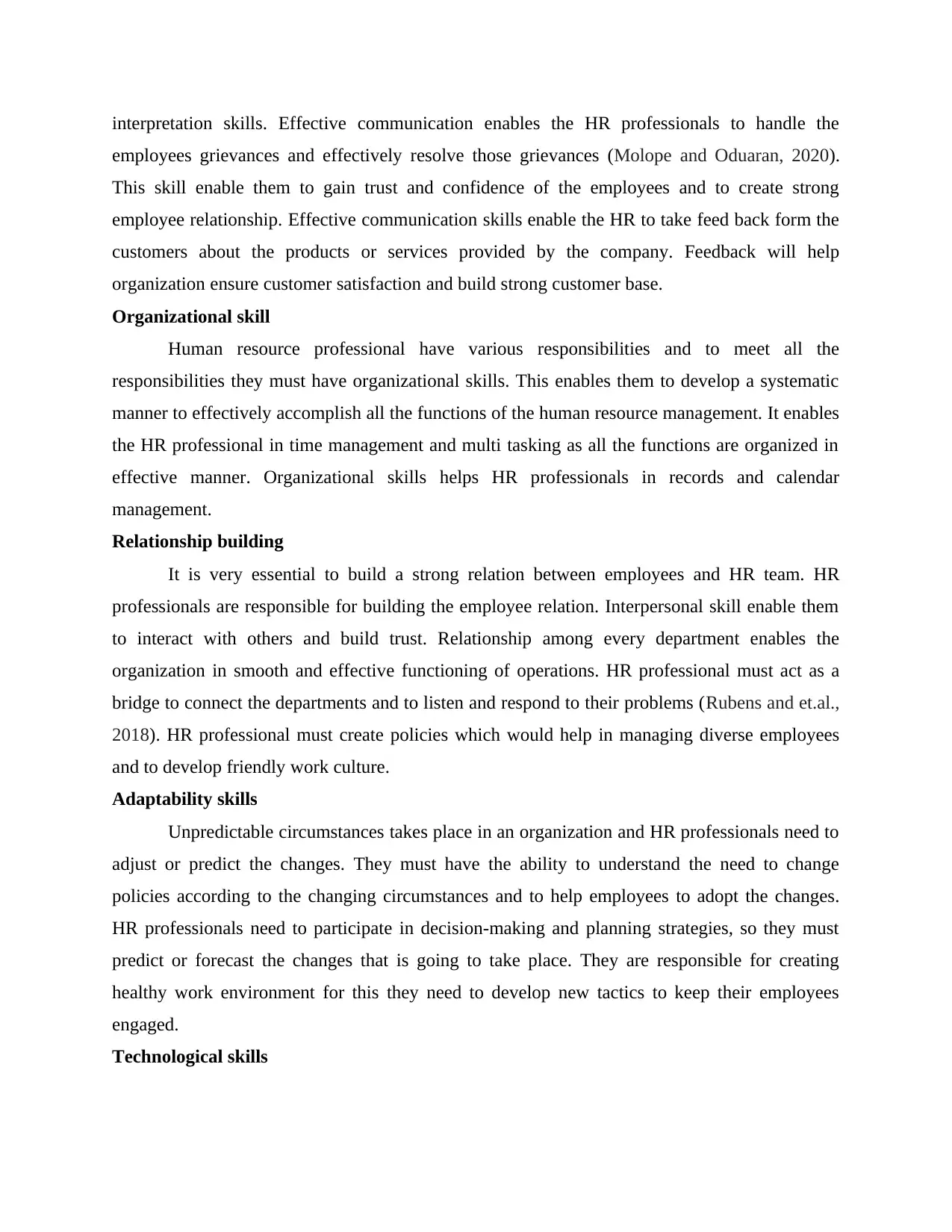
interpretation skills. Effective communication enables the HR professionals to handle the
employees grievances and effectively resolve those grievances (Molope and Oduaran, 2020).
This skill enable them to gain trust and confidence of the employees and to create strong
employee relationship. Effective communication skills enable the HR to take feed back form the
customers about the products or services provided by the company. Feedback will help
organization ensure customer satisfaction and build strong customer base.
Organizational skill
Human resource professional have various responsibilities and to meet all the
responsibilities they must have organizational skills. This enables them to develop a systematic
manner to effectively accomplish all the functions of the human resource management. It enables
the HR professional in time management and multi tasking as all the functions are organized in
effective manner. Organizational skills helps HR professionals in records and calendar
management.
Relationship building
It is very essential to build a strong relation between employees and HR team. HR
professionals are responsible for building the employee relation. Interpersonal skill enable them
to interact with others and build trust. Relationship among every department enables the
organization in smooth and effective functioning of operations. HR professional must act as a
bridge to connect the departments and to listen and respond to their problems (Rubens and et.al.,
2018). HR professional must create policies which would help in managing diverse employees
and to develop friendly work culture.
Adaptability skills
Unpredictable circumstances takes place in an organization and HR professionals need to
adjust or predict the changes. They must have the ability to understand the need to change
policies according to the changing circumstances and to help employees to adopt the changes.
HR professionals need to participate in decision-making and planning strategies, so they must
predict or forecast the changes that is going to take place. They are responsible for creating
healthy work environment for this they need to develop new tactics to keep their employees
engaged.
Technological skills
employees grievances and effectively resolve those grievances (Molope and Oduaran, 2020).
This skill enable them to gain trust and confidence of the employees and to create strong
employee relationship. Effective communication skills enable the HR to take feed back form the
customers about the products or services provided by the company. Feedback will help
organization ensure customer satisfaction and build strong customer base.
Organizational skill
Human resource professional have various responsibilities and to meet all the
responsibilities they must have organizational skills. This enables them to develop a systematic
manner to effectively accomplish all the functions of the human resource management. It enables
the HR professional in time management and multi tasking as all the functions are organized in
effective manner. Organizational skills helps HR professionals in records and calendar
management.
Relationship building
It is very essential to build a strong relation between employees and HR team. HR
professionals are responsible for building the employee relation. Interpersonal skill enable them
to interact with others and build trust. Relationship among every department enables the
organization in smooth and effective functioning of operations. HR professional must act as a
bridge to connect the departments and to listen and respond to their problems (Rubens and et.al.,
2018). HR professional must create policies which would help in managing diverse employees
and to develop friendly work culture.
Adaptability skills
Unpredictable circumstances takes place in an organization and HR professionals need to
adjust or predict the changes. They must have the ability to understand the need to change
policies according to the changing circumstances and to help employees to adopt the changes.
HR professionals need to participate in decision-making and planning strategies, so they must
predict or forecast the changes that is going to take place. They are responsible for creating
healthy work environment for this they need to develop new tactics to keep their employees
engaged.
Technological skills

Technology is up grading every day and HR professionals must have technological skills
to cope up with the changing technology (Mazurchenko and Maršíková, 2019). Technological
skills enable HR professionals to manage all the duties. The duties of HR professionals are
recruitment, training, tracking payroll, retaining efficient employees, etc.
Leadership
HR need to lead the employees towards accomplishing the goals and objectives of the
organization. To improve the performance of the employees it is essential to have a good leader
who can motivate the employees. Leadership skills in HR enables them to help the employees to
work efficiently and coordinate with each other in a team.
By conducting personal audit I have identified the professional skills, knowledge and
behaviour that I need as HR professional. I have an effective communication skills which would
enable me to communicate with the employees of the organization and build strong relationship.
The interpersonal skills will enable me to influence others and develop trust and confidence. This
would also help me to get feedback from the employees and ensure employees satisfaction and
retention. Time management and multi tasking skills help me to do all my duties in an
organization and timely manner (Sinambela and et.al., 2020). This would be advantageous for
the organization as all the duties and activities would be completed on time. Creative thinking
and curiosity would enable me to analyse and evaluate all the circumstances and help me in
taking decisions which would be beneficial for the organization. I can quickly and easily adapt
myself in any situation or circumstances. This adaptability skills will enable me to forecast the
upcoming circumstances and take corrective measures.
The skills that is lacking in me are technological skills, leadership skills and courage to
take challenges. The rapid change in technology would be a threat for me as I don't have
technological skills. HR professionals are the one who give direction to the employees to work in
a team to achieve the goals. The lack of leadership skill may negatively impact the operations of
the organization. I don't have the ability to encourage and motivate people so that they can
improve their performance. The lack of confidence to face the challenges is a weakness in me
which I need to overcome so that I can work efficiently as HR professional in an organization. I
need to take actions to overcome all my weaknesses so that I can improve my performance as
HR professional and contribute in the success of the business.
to cope up with the changing technology (Mazurchenko and Maršíková, 2019). Technological
skills enable HR professionals to manage all the duties. The duties of HR professionals are
recruitment, training, tracking payroll, retaining efficient employees, etc.
Leadership
HR need to lead the employees towards accomplishing the goals and objectives of the
organization. To improve the performance of the employees it is essential to have a good leader
who can motivate the employees. Leadership skills in HR enables them to help the employees to
work efficiently and coordinate with each other in a team.
By conducting personal audit I have identified the professional skills, knowledge and
behaviour that I need as HR professional. I have an effective communication skills which would
enable me to communicate with the employees of the organization and build strong relationship.
The interpersonal skills will enable me to influence others and develop trust and confidence. This
would also help me to get feedback from the employees and ensure employees satisfaction and
retention. Time management and multi tasking skills help me to do all my duties in an
organization and timely manner (Sinambela and et.al., 2020). This would be advantageous for
the organization as all the duties and activities would be completed on time. Creative thinking
and curiosity would enable me to analyse and evaluate all the circumstances and help me in
taking decisions which would be beneficial for the organization. I can quickly and easily adapt
myself in any situation or circumstances. This adaptability skills will enable me to forecast the
upcoming circumstances and take corrective measures.
The skills that is lacking in me are technological skills, leadership skills and courage to
take challenges. The rapid change in technology would be a threat for me as I don't have
technological skills. HR professionals are the one who give direction to the employees to work in
a team to achieve the goals. The lack of leadership skill may negatively impact the operations of
the organization. I don't have the ability to encourage and motivate people so that they can
improve their performance. The lack of confidence to face the challenges is a weakness in me
which I need to overcome so that I can work efficiently as HR professional in an organization. I
need to take actions to overcome all my weaknesses so that I can improve my performance as
HR professional and contribute in the success of the business.
⊘ This is a preview!⊘
Do you want full access?
Subscribe today to unlock all pages.

Trusted by 1+ million students worldwide
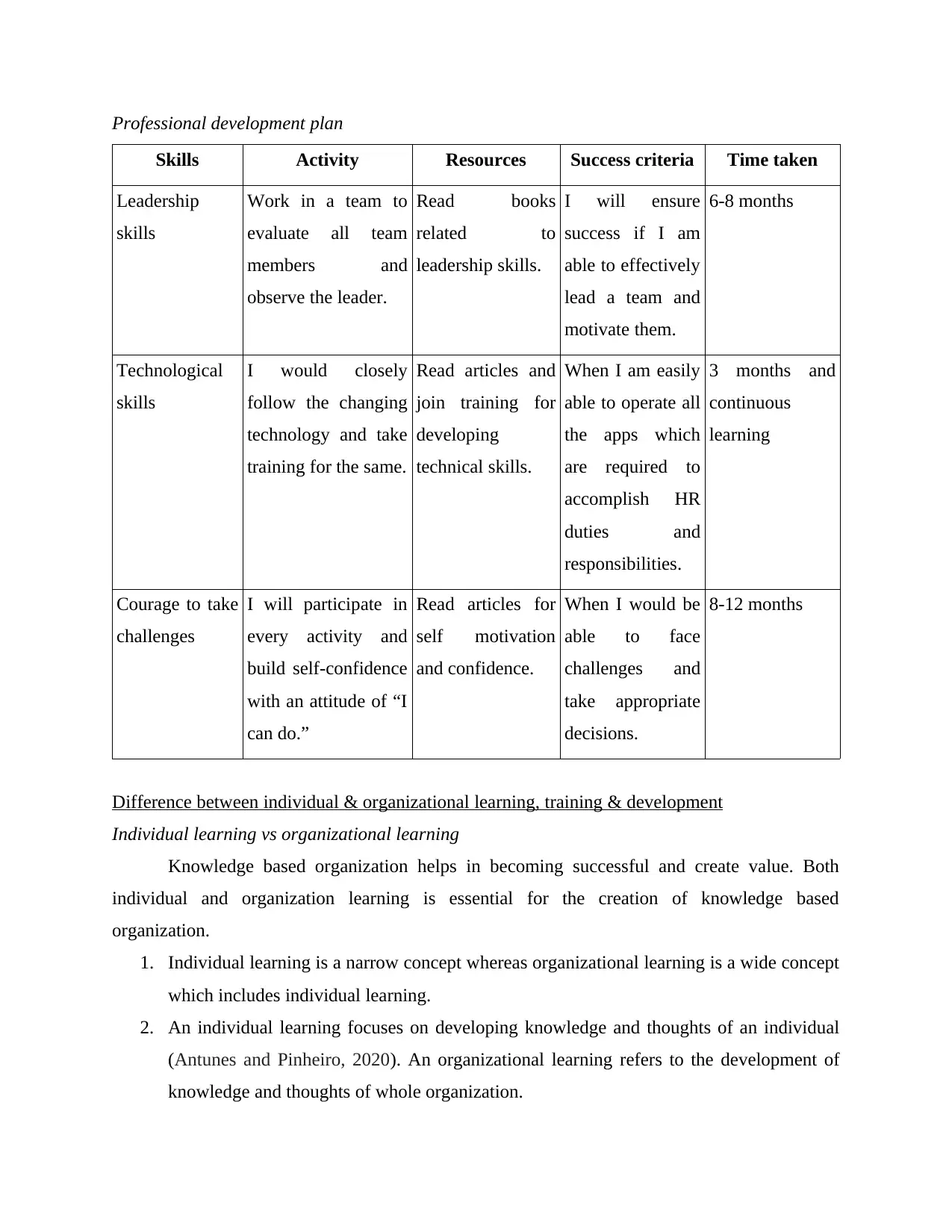
Professional development plan
Skills Activity Resources Success criteria Time taken
Leadership
skills
Work in a team to
evaluate all team
members and
observe the leader.
Read books
related to
leadership skills.
I will ensure
success if I am
able to effectively
lead a team and
motivate them.
6-8 months
Technological
skills
I would closely
follow the changing
technology and take
training for the same.
Read articles and
join training for
developing
technical skills.
When I am easily
able to operate all
the apps which
are required to
accomplish HR
duties and
responsibilities.
3 months and
continuous
learning
Courage to take
challenges
I will participate in
every activity and
build self-confidence
with an attitude of “I
can do.”
Read articles for
self motivation
and confidence.
When I would be
able to face
challenges and
take appropriate
decisions.
8-12 months
Difference between individual & organizational learning, training & development
Individual learning vs organizational learning
Knowledge based organization helps in becoming successful and create value. Both
individual and organization learning is essential for the creation of knowledge based
organization.
1. Individual learning is a narrow concept whereas organizational learning is a wide concept
which includes individual learning.
2. An individual learning focuses on developing knowledge and thoughts of an individual
(Antunes and Pinheiro, 2020). An organizational learning refers to the development of
knowledge and thoughts of whole organization.
Skills Activity Resources Success criteria Time taken
Leadership
skills
Work in a team to
evaluate all team
members and
observe the leader.
Read books
related to
leadership skills.
I will ensure
success if I am
able to effectively
lead a team and
motivate them.
6-8 months
Technological
skills
I would closely
follow the changing
technology and take
training for the same.
Read articles and
join training for
developing
technical skills.
When I am easily
able to operate all
the apps which
are required to
accomplish HR
duties and
responsibilities.
3 months and
continuous
learning
Courage to take
challenges
I will participate in
every activity and
build self-confidence
with an attitude of “I
can do.”
Read articles for
self motivation
and confidence.
When I would be
able to face
challenges and
take appropriate
decisions.
8-12 months
Difference between individual & organizational learning, training & development
Individual learning vs organizational learning
Knowledge based organization helps in becoming successful and create value. Both
individual and organization learning is essential for the creation of knowledge based
organization.
1. Individual learning is a narrow concept whereas organizational learning is a wide concept
which includes individual learning.
2. An individual learning focuses on developing knowledge and thoughts of an individual
(Antunes and Pinheiro, 2020). An organizational learning refers to the development of
knowledge and thoughts of whole organization.
Paraphrase This Document
Need a fresh take? Get an instant paraphrase of this document with our AI Paraphraser
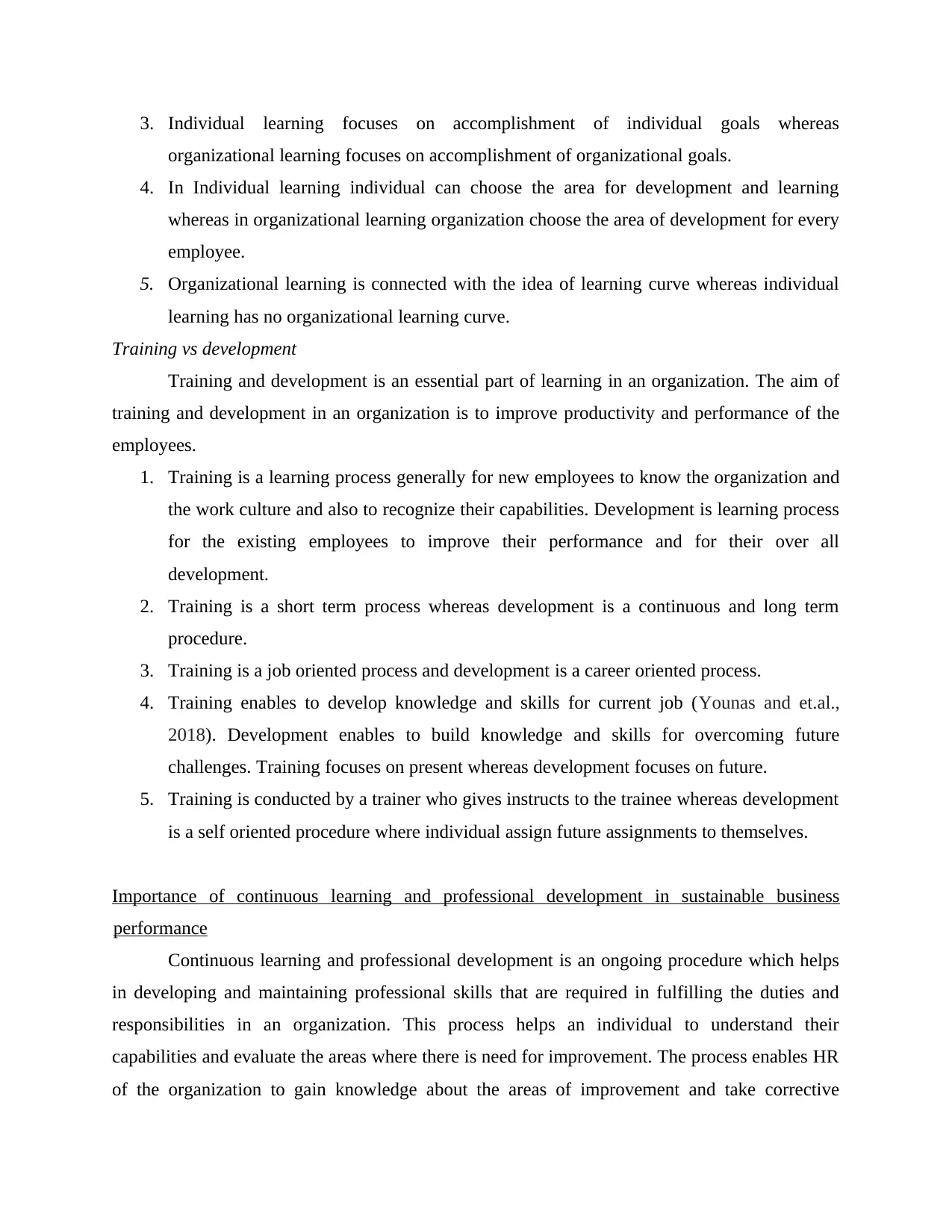
3. Individual learning focuses on accomplishment of individual goals whereas
organizational learning focuses on accomplishment of organizational goals.
4. In Individual learning individual can choose the area for development and learning
whereas in organizational learning organization choose the area of development for every
employee.
5. Organizational learning is connected with the idea of learning curve whereas individual
learning has no organizational learning curve.
Training vs development
Training and development is an essential part of learning in an organization. The aim of
training and development in an organization is to improve productivity and performance of the
employees.
1. Training is a learning process generally for new employees to know the organization and
the work culture and also to recognize their capabilities. Development is learning process
for the existing employees to improve their performance and for their over all
development.
2. Training is a short term process whereas development is a continuous and long term
procedure.
3. Training is a job oriented process and development is a career oriented process.
4. Training enables to develop knowledge and skills for current job (Younas and et.al.,
2018). Development enables to build knowledge and skills for overcoming future
challenges. Training focuses on present whereas development focuses on future.
5. Training is conducted by a trainer who gives instructs to the trainee whereas development
is a self oriented procedure where individual assign future assignments to themselves.
Importance of continuous learning and professional development in sustainable business
performance
Continuous learning and professional development is an ongoing procedure which helps
in developing and maintaining professional skills that are required in fulfilling the duties and
responsibilities in an organization. This process helps an individual to understand their
capabilities and evaluate the areas where there is need for improvement. The process enables HR
of the organization to gain knowledge about the areas of improvement and take corrective
organizational learning focuses on accomplishment of organizational goals.
4. In Individual learning individual can choose the area for development and learning
whereas in organizational learning organization choose the area of development for every
employee.
5. Organizational learning is connected with the idea of learning curve whereas individual
learning has no organizational learning curve.
Training vs development
Training and development is an essential part of learning in an organization. The aim of
training and development in an organization is to improve productivity and performance of the
employees.
1. Training is a learning process generally for new employees to know the organization and
the work culture and also to recognize their capabilities. Development is learning process
for the existing employees to improve their performance and for their over all
development.
2. Training is a short term process whereas development is a continuous and long term
procedure.
3. Training is a job oriented process and development is a career oriented process.
4. Training enables to develop knowledge and skills for current job (Younas and et.al.,
2018). Development enables to build knowledge and skills for overcoming future
challenges. Training focuses on present whereas development focuses on future.
5. Training is conducted by a trainer who gives instructs to the trainee whereas development
is a self oriented procedure where individual assign future assignments to themselves.
Importance of continuous learning and professional development in sustainable business
performance
Continuous learning and professional development is an ongoing procedure which helps
in developing and maintaining professional skills that are required in fulfilling the duties and
responsibilities in an organization. This process helps an individual to understand their
capabilities and evaluate the areas where there is need for improvement. The process enables HR
of the organization to gain knowledge about the areas of improvement and take corrective
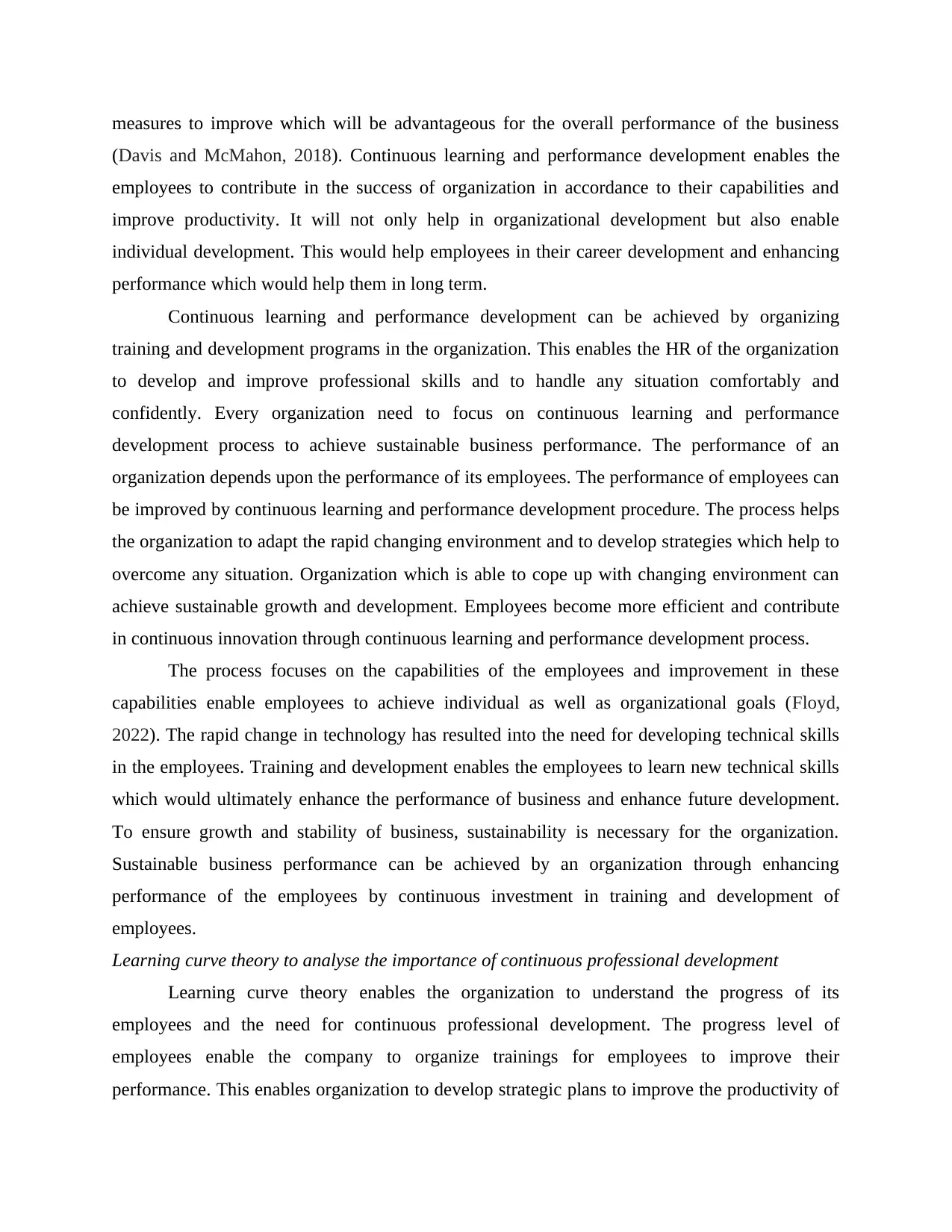
measures to improve which will be advantageous for the overall performance of the business
(Davis and McMahon, 2018). Continuous learning and performance development enables the
employees to contribute in the success of organization in accordance to their capabilities and
improve productivity. It will not only help in organizational development but also enable
individual development. This would help employees in their career development and enhancing
performance which would help them in long term.
Continuous learning and performance development can be achieved by organizing
training and development programs in the organization. This enables the HR of the organization
to develop and improve professional skills and to handle any situation comfortably and
confidently. Every organization need to focus on continuous learning and performance
development process to achieve sustainable business performance. The performance of an
organization depends upon the performance of its employees. The performance of employees can
be improved by continuous learning and performance development procedure. The process helps
the organization to adapt the rapid changing environment and to develop strategies which help to
overcome any situation. Organization which is able to cope up with changing environment can
achieve sustainable growth and development. Employees become more efficient and contribute
in continuous innovation through continuous learning and performance development process.
The process focuses on the capabilities of the employees and improvement in these
capabilities enable employees to achieve individual as well as organizational goals (Floyd,
2022). The rapid change in technology has resulted into the need for developing technical skills
in the employees. Training and development enables the employees to learn new technical skills
which would ultimately enhance the performance of business and enhance future development.
To ensure growth and stability of business, sustainability is necessary for the organization.
Sustainable business performance can be achieved by an organization through enhancing
performance of the employees by continuous investment in training and development of
employees.
Learning curve theory to analyse the importance of continuous professional development
Learning curve theory enables the organization to understand the progress of its
employees and the need for continuous professional development. The progress level of
employees enable the company to organize trainings for employees to improve their
performance. This enables organization to develop strategic plans to improve the productivity of
(Davis and McMahon, 2018). Continuous learning and performance development enables the
employees to contribute in the success of organization in accordance to their capabilities and
improve productivity. It will not only help in organizational development but also enable
individual development. This would help employees in their career development and enhancing
performance which would help them in long term.
Continuous learning and performance development can be achieved by organizing
training and development programs in the organization. This enables the HR of the organization
to develop and improve professional skills and to handle any situation comfortably and
confidently. Every organization need to focus on continuous learning and performance
development process to achieve sustainable business performance. The performance of an
organization depends upon the performance of its employees. The performance of employees can
be improved by continuous learning and performance development procedure. The process helps
the organization to adapt the rapid changing environment and to develop strategies which help to
overcome any situation. Organization which is able to cope up with changing environment can
achieve sustainable growth and development. Employees become more efficient and contribute
in continuous innovation through continuous learning and performance development process.
The process focuses on the capabilities of the employees and improvement in these
capabilities enable employees to achieve individual as well as organizational goals (Floyd,
2022). The rapid change in technology has resulted into the need for developing technical skills
in the employees. Training and development enables the employees to learn new technical skills
which would ultimately enhance the performance of business and enhance future development.
To ensure growth and stability of business, sustainability is necessary for the organization.
Sustainable business performance can be achieved by an organization through enhancing
performance of the employees by continuous investment in training and development of
employees.
Learning curve theory to analyse the importance of continuous professional development
Learning curve theory enables the organization to understand the progress of its
employees and the need for continuous professional development. The progress level of
employees enable the company to organize trainings for employees to improve their
performance. This enables organization to develop strategic plans to improve the productivity of
⊘ This is a preview!⊘
Do you want full access?
Subscribe today to unlock all pages.

Trusted by 1+ million students worldwide

employees (Ben-Eliyahu, 2019). Learning curve helps to motivate the workforce by creating
healthy work culture. This enables the company to forecast the future and make decisions. There
are four stages of leaning curve.
Concrete experience
In this stage the learner can learn and develop new things by relying more on feeling than
on systematic approach. The learner would develop the ability to adapt changes and solve
problems.
Reflective observation
In this stage the learner learn from their own actions, thoughts and feelings. They would
rely on ideas and situation with different point of view and take judgement by maintaining
patience and careful observations.
Abstract conceptualization
In this learning stage, learner uses theories, ideas and logics to understand and resolve
any problem rather than depending upon their own feelings. They rely on systematic learning
and theories to solve any problem.
Active experimentation
The learners do experiments with different situations to come at any conclusion. They
rely on practical approach to take any decisions to overcome the problems.
Advantages of applying high performance working in an organization
High performance working refers to creating a work culture that enables to improve the
performance of the organization by hiring, developing and retaining high performing employees.
It is HR practice aimed to enhance skills and productivity of employees resulting into their
commitment towards organization. This enables the transfer of human resource into source of
competitive advantages. HPW provides employees training, improving performance and
enabling career development and providing a healthy work culture. It focuses on providing
support to employees and enhancing their performance and development by providing them
training so that they can learn new skills and develop knowledge (Huang, Ma and Meng, 2018).
This enables organization to ensure employee satisfaction and improving productivity and
performance of employees. Ultimately, this leads to achievement of employee engagement and
competitive advantages. Employees engagement refers to the dedication and commitment of
healthy work culture. This enables the company to forecast the future and make decisions. There
are four stages of leaning curve.
Concrete experience
In this stage the learner can learn and develop new things by relying more on feeling than
on systematic approach. The learner would develop the ability to adapt changes and solve
problems.
Reflective observation
In this stage the learner learn from their own actions, thoughts and feelings. They would
rely on ideas and situation with different point of view and take judgement by maintaining
patience and careful observations.
Abstract conceptualization
In this learning stage, learner uses theories, ideas and logics to understand and resolve
any problem rather than depending upon their own feelings. They rely on systematic learning
and theories to solve any problem.
Active experimentation
The learners do experiments with different situations to come at any conclusion. They
rely on practical approach to take any decisions to overcome the problems.
Advantages of applying high performance working in an organization
High performance working refers to creating a work culture that enables to improve the
performance of the organization by hiring, developing and retaining high performing employees.
It is HR practice aimed to enhance skills and productivity of employees resulting into their
commitment towards organization. This enables the transfer of human resource into source of
competitive advantages. HPW provides employees training, improving performance and
enabling career development and providing a healthy work culture. It focuses on providing
support to employees and enhancing their performance and development by providing them
training so that they can learn new skills and develop knowledge (Huang, Ma and Meng, 2018).
This enables organization to ensure employee satisfaction and improving productivity and
performance of employees. Ultimately, this leads to achievement of employee engagement and
competitive advantages. Employees engagement refers to the dedication and commitment of
Paraphrase This Document
Need a fresh take? Get an instant paraphrase of this document with our AI Paraphraser

employees towards the organization. This result into achievement of competitive advantage as it
reduce employee turnover ratio and retention of talented and skilled employees.
Competitive advantage enables the organization to improve its performance in the market
and increase profit margin. The organization also encourage them to participate in decision-
making and increase work engagement which lead to employee satisfaction and increase
organizational performance. Organization applies HPW with an expectation that employees will
give return on the investment through high engagement and commitment. HPW is applied in an
organization with the aim of achieving high employee engagement and competitive advantage.
Implementation of HPW improves the level of innovation and commitment of employees in an
organization (Cooke and et.al., 2019). With increase in level of innovation organization is able to
take risk and expand its business through new products and services. HPW has lead to
organizational learning and through organizational learning employees can gain knowledge and
improve their performance. The motivated and satisfied employees put all their efforts in
achieving the organizational goals and objectives.
Different approaches to performance management and their support to implement high
performance culture and commitment
Performance management is the process which is used to link the employee performance
with the mission, vision, strategies and goals of the organization. It enables the HR to evaluate
the performance of employees. It helps to link the goal of employees with the organizational
goals and objectives. This helps the HR to motivate employees by providing rewards and
incentive according to their performance level (Dorta-Afonso and et.al., 2021). An effective
performance management approach is the one with following features:
It must communicate the contribution of employees in success of business.
It must align individual goals with organization's goals resulting into efficient utilization
of resources.
It should clarify the best way to invest energy to avoid wastage of time and value. It should create a systematic process for measuring progress against set goals and take
corrective measures if required.
The effective performance management approaches
Establish KPI
reduce employee turnover ratio and retention of talented and skilled employees.
Competitive advantage enables the organization to improve its performance in the market
and increase profit margin. The organization also encourage them to participate in decision-
making and increase work engagement which lead to employee satisfaction and increase
organizational performance. Organization applies HPW with an expectation that employees will
give return on the investment through high engagement and commitment. HPW is applied in an
organization with the aim of achieving high employee engagement and competitive advantage.
Implementation of HPW improves the level of innovation and commitment of employees in an
organization (Cooke and et.al., 2019). With increase in level of innovation organization is able to
take risk and expand its business through new products and services. HPW has lead to
organizational learning and through organizational learning employees can gain knowledge and
improve their performance. The motivated and satisfied employees put all their efforts in
achieving the organizational goals and objectives.
Different approaches to performance management and their support to implement high
performance culture and commitment
Performance management is the process which is used to link the employee performance
with the mission, vision, strategies and goals of the organization. It enables the HR to evaluate
the performance of employees. It helps to link the goal of employees with the organizational
goals and objectives. This helps the HR to motivate employees by providing rewards and
incentive according to their performance level (Dorta-Afonso and et.al., 2021). An effective
performance management approach is the one with following features:
It must communicate the contribution of employees in success of business.
It must align individual goals with organization's goals resulting into efficient utilization
of resources.
It should clarify the best way to invest energy to avoid wastage of time and value. It should create a systematic process for measuring progress against set goals and take
corrective measures if required.
The effective performance management approaches
Establish KPI
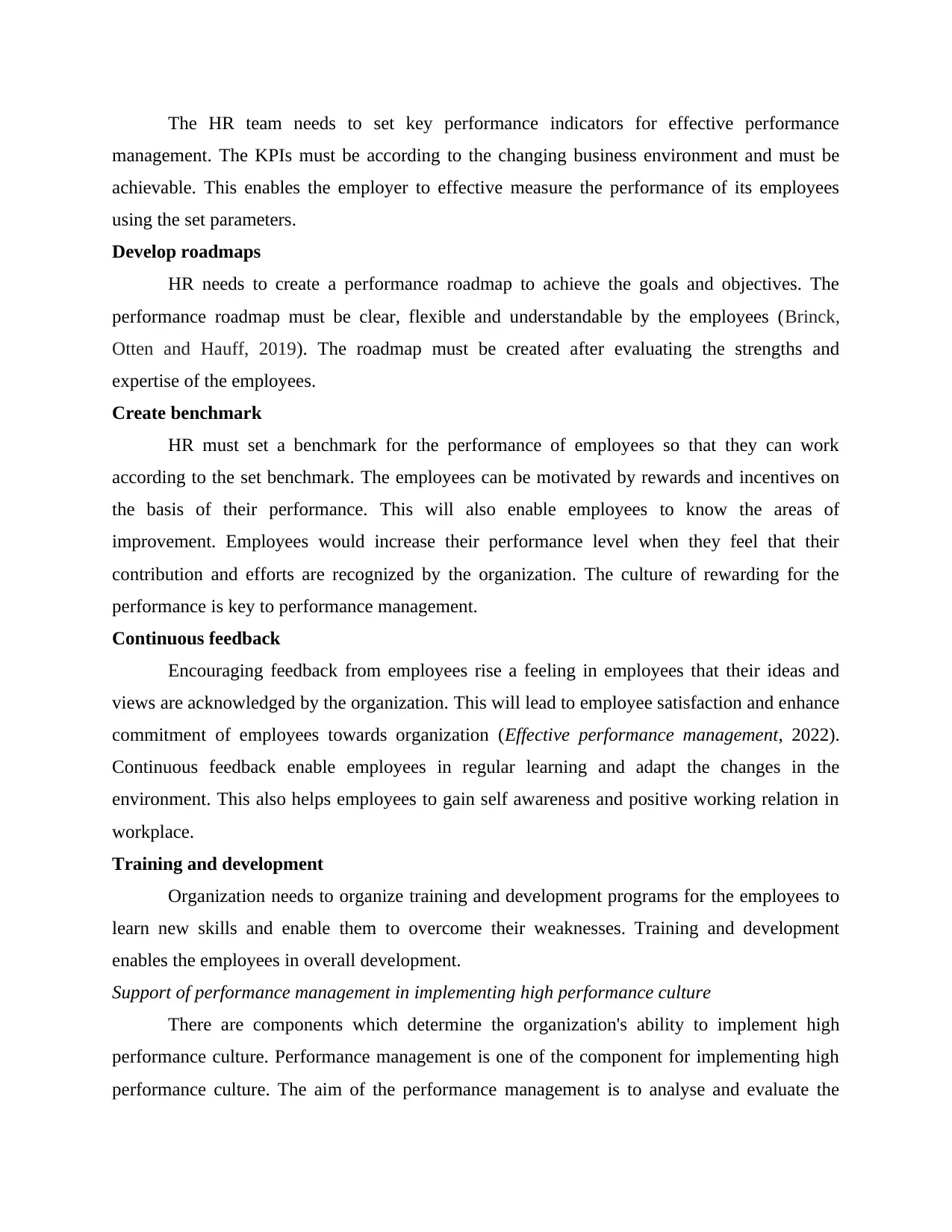
The HR team needs to set key performance indicators for effective performance
management. The KPIs must be according to the changing business environment and must be
achievable. This enables the employer to effective measure the performance of its employees
using the set parameters.
Develop roadmaps
HR needs to create a performance roadmap to achieve the goals and objectives. The
performance roadmap must be clear, flexible and understandable by the employees (Brinck,
Otten and Hauff, 2019). The roadmap must be created after evaluating the strengths and
expertise of the employees.
Create benchmark
HR must set a benchmark for the performance of employees so that they can work
according to the set benchmark. The employees can be motivated by rewards and incentives on
the basis of their performance. This will also enable employees to know the areas of
improvement. Employees would increase their performance level when they feel that their
contribution and efforts are recognized by the organization. The culture of rewarding for the
performance is key to performance management.
Continuous feedback
Encouraging feedback from employees rise a feeling in employees that their ideas and
views are acknowledged by the organization. This will lead to employee satisfaction and enhance
commitment of employees towards organization (Effective performance management, 2022).
Continuous feedback enable employees in regular learning and adapt the changes in the
environment. This also helps employees to gain self awareness and positive working relation in
workplace.
Training and development
Organization needs to organize training and development programs for the employees to
learn new skills and enable them to overcome their weaknesses. Training and development
enables the employees in overall development.
Support of performance management in implementing high performance culture
There are components which determine the organization's ability to implement high
performance culture. Performance management is one of the component for implementing high
performance culture. The aim of the performance management is to analyse and evaluate the
management. The KPIs must be according to the changing business environment and must be
achievable. This enables the employer to effective measure the performance of its employees
using the set parameters.
Develop roadmaps
HR needs to create a performance roadmap to achieve the goals and objectives. The
performance roadmap must be clear, flexible and understandable by the employees (Brinck,
Otten and Hauff, 2019). The roadmap must be created after evaluating the strengths and
expertise of the employees.
Create benchmark
HR must set a benchmark for the performance of employees so that they can work
according to the set benchmark. The employees can be motivated by rewards and incentives on
the basis of their performance. This will also enable employees to know the areas of
improvement. Employees would increase their performance level when they feel that their
contribution and efforts are recognized by the organization. The culture of rewarding for the
performance is key to performance management.
Continuous feedback
Encouraging feedback from employees rise a feeling in employees that their ideas and
views are acknowledged by the organization. This will lead to employee satisfaction and enhance
commitment of employees towards organization (Effective performance management, 2022).
Continuous feedback enable employees in regular learning and adapt the changes in the
environment. This also helps employees to gain self awareness and positive working relation in
workplace.
Training and development
Organization needs to organize training and development programs for the employees to
learn new skills and enable them to overcome their weaknesses. Training and development
enables the employees in overall development.
Support of performance management in implementing high performance culture
There are components which determine the organization's ability to implement high
performance culture. Performance management is one of the component for implementing high
performance culture. The aim of the performance management is to analyse and evaluate the
⊘ This is a preview!⊘
Do you want full access?
Subscribe today to unlock all pages.

Trusted by 1+ million students worldwide
1 out of 14
Related Documents
Your All-in-One AI-Powered Toolkit for Academic Success.
+13062052269
info@desklib.com
Available 24*7 on WhatsApp / Email
![[object Object]](/_next/static/media/star-bottom.7253800d.svg)
Unlock your academic potential
Copyright © 2020–2025 A2Z Services. All Rights Reserved. Developed and managed by ZUCOL.




